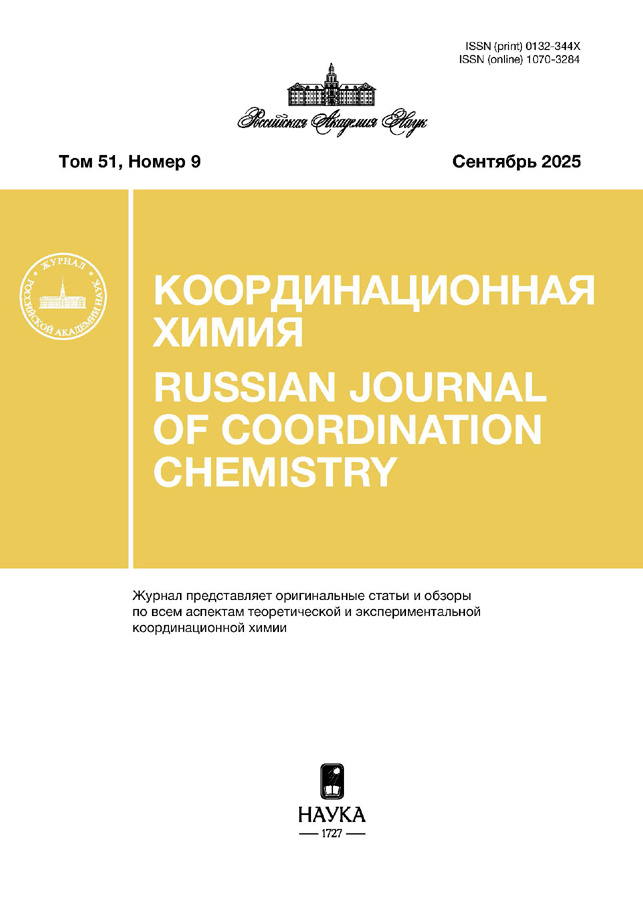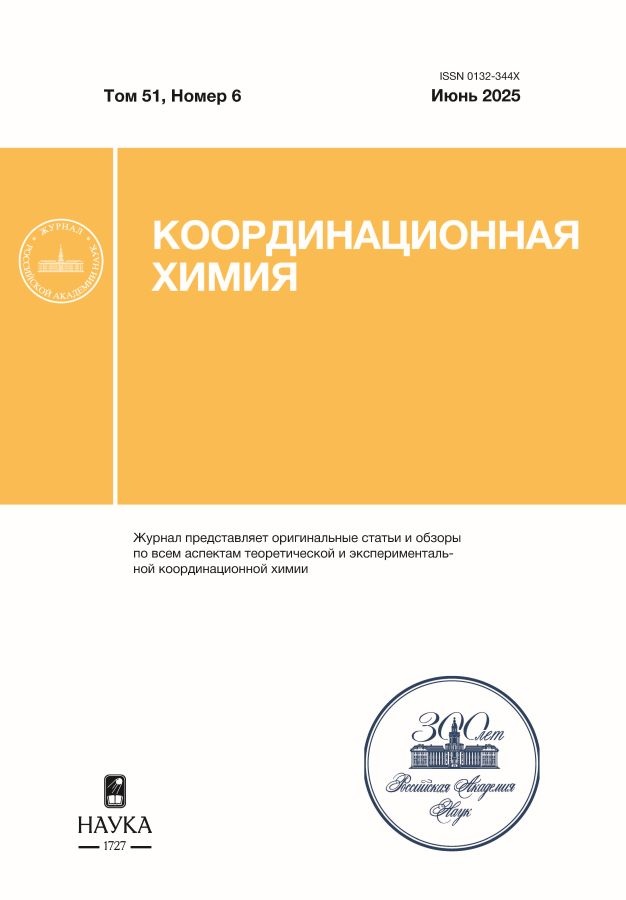Биядерные комплексы дифенилолова(IV) с салицилальдиминовыми лигандами: синтез, строение, электрохимические свойства
- Авторы: Клок В.А.1, Шангин П.Г.1, Крылова И.В.1, Миняев М.Е.1, Сыроешкин М.А.1, Печенников В.М.2, Егоров М.П.1, Николаевская Е.Н.1
-
Учреждения:
- Институт органической химии им. Н. Д. Зелинского РАН
- Первый Московский государственный медицинский университет им. И. М. Сеченова
- Выпуск: Том 51, № 6 (2025)
- Страницы: 355-365
- Раздел: Статьи
- URL: https://kazanmedjournal.ru/0132-344X/article/view/687245
- DOI: https://doi.org/10.31857/S0132344X25060011
- EDN: https://elibrary.ru/KIDIZC
- ID: 687245
Цитировать
Полный текст
Аннотация
Конденсацией дифенилолово оксида Ph2SnO с рядом оснований Шиффа на основе салицилового альдегида получены новые биядерные комплексы олова(IV). Строение комплексов подтверждено методами спектроскопии ЯМР на ядрах 1Н, 13С и 119Sn, а также рентгеноструктурного анализа (CCDC № 2433411). Исследование комплексов с помощью УФ-спектроскопии показало, что при комплексообразовании с металлофрагментом наблюдается батохромный сдвиг всех полос поглощения лигандов. Способность комплексов к электрохимическим превращениям исследована с помощью циклической вольтамперометрии. Во всех случаях окисление и восстановление комплексов носит необратимый характер. Для комплексов с сопряженным мостиком окисление двух координированных фенолятных групп лигандов происходит одновременно при одном потенциале, тогда как комплекс с несопряженным адипиновым мостиком имеет на кривой окисления два пика при различных потенциалах, что связано, вероятно, с тем, что окисление двух различных “концов” молекулы протекает при разных потенциалах.
Полный текст
Об авторах
В. А. Клок
Институт органической химии им. Н. Д. Зелинского РАН
Email: en@ioc.ac.ru
Россия, Москва, 119991
П. Г. Шангин
Институт органической химии им. Н. Д. Зелинского РАН
Email: en@ioc.ac.ru
Россия, Москва, 119991
И. В. Крылова
Институт органической химии им. Н. Д. Зелинского РАН
Email: en@ioc.ac.ru
Россия, Москва, 119991
М. Е. Миняев
Институт органической химии им. Н. Д. Зелинского РАН
Email: en@ioc.ac.ru
Россия, Москва, 119991
М. А. Сыроешкин
Институт органической химии им. Н. Д. Зелинского РАН
Email: en@ioc.ac.ru
Россия, Москва, 119991
В. М. Печенников
Первый Московский государственный медицинский университет им. И. М. Сеченова
Email: en@ioc.ac.ru
Россия, Москва, 119048
М. П. Егоров
Институт органической химии им. Н. Д. Зелинского РАН
Email: en@ioc.ac.ru
Россия, Москва, 119991
Е. Н. Николаевская
Институт органической химии им. Н. Д. Зелинского РАН
Автор, ответственный за переписку.
Email: en@ioc.ac.ru
Россия, Москва, 119991
Список литературы
- Nikolaevskaya E.N., Syroeshkin M.A., Egorov M.P. // Mend. Commun. 2023. V. 33, P. 733. https://doi.org/10.1016/j.mencom.2023.10.001
- Cozzi P.G. // Chem. Soc. Rev. 2004. V. 33. P. 410. https://doi.org/10.1039/b307853c
- Fallah-Mehrjardi M., Kargar H., Munawar K.S. // Inorg. Chim. Acta. 2024. V. 560. P. 121835. https://doi.org/10.1016/j.ica.2023.121835
- Juyal V.K., A. Pathak M., Panwar S.C. et al. // J. Organomet. Chem. 2023. V. 999. P. 122825. https://doi.org/10.1016/j.jorganchem.2023.122825
- Iacopetta D., Catalano A., Ceramella J. et al. // Molecules. 2025. V. 30. P. 207. https://doi.org/10.3390/molecules30020207
- Lindoy L.F., Park K.-M., Lee S.S. // Chem. Soc. Rev. 2013. V. 42. P. 1713. https://doi.org/10.1039/C2CS35218D
- Middya P., Roy D., Chattopadhyay S. // Inorg. Chim. Acta. 2023. V. 548. P. 121377. https://doi.org/10.1016/j.ica.2023.121377
- Zhang J., Xu L., Wong W.-Y. // Coord. Chem. Rev. 2018. V. 355. P. 180. https://doi.org/10.1016/j.ccr.2017.08.007
- Akbulatov A.F., Akyeva A.Y., Shangin P.G. et al. // Membranes. 2023. V. 13. P. 439. https://doi.org/10.3390/membranes13040439
- Singh H.L., Khaturia S., Solanki V.S. et al. // J. Indian Chem. Soc. 2023. V. 100. P. 100945. https://doi.org/10.1016/j.jics.2023.100945
- Dieng M., Gningue-Sall D., Jouikov V. // Main Group Met. Chem. 2012. V. 35. P. 141. https://doi.org/10.1515/mgmc-2012-0059
- Nikolaevskaya E.N., Saverina E.A., Starikova A.A. et al. // Dalton Trans. 2018. V. 47. P. 17127. https://doi.org/10.1039/C8DT03397H
- Nikolaevskaya E.N., Shangin P.G., Starikova et al. // Inorg. Chim. Acta. 2019. V. 495. P. 119007. https://doi.org/10.1016/j.ica.2019.119007
- Shangin P.G., Krylova I.V., Lalov A.V. et al. // RSC Adv. 2021. V. 11. P. 21527. https://doi.org/10.1039/D1RA02691G
- Shangin P.G., Akyeva A.Y., Vakhrusheva D.M. et al. // Organometallics. 2023. V. 42. P. 2541. https://doi.org/10.1021/acs.organomet.2c00607
- Kozmenkova A.Y., Timofeeva V.A., Mankaev B.N. et al. // Eur. J. Inorg. Chem. 2021. P. 2755. https://doi.org/10.1002/ejic.202100369
- Baryshnikova S.V., Bellan E.V., Poddel’sky A.I. et al. // Eur. J. Inorg. Chem. 2016. V. 2016. P. 5230. https://doi.org/10.1002/ejic.201600885
- Baryshnikova S.V., Poddel’sky A.I., Bellan E.V. et al. // Inorg. Chem. 2020. V. 59. P. 6774. https://doi.org/10.1021/acs.inorgchem.9b03757
- Baryshnikova S.V., Bellan E.V., Poddel’sky A.I. et al // Inorg. Chem. Comm. 2016. V. 69. P. 94. https://doi.org/10.1016/j.inoche.2016.05.003
- Smolyaninov I.V., Burmistrova D.A., Pomortseva N.P. et al. // Russ. J. Coord. Chem. 2023. V. 49. P. 124. https://doi.org/10.1134/S1070328423700446
- Protasenko N.A., Baryshnikova S.V., Cherkasov A.V. et al. // Russ. J. Coord. Chem. 2022. V. 48. P. 478. https://doi.org/10.1134/S1070328422070077
- Piskunov A.V., Trofimova O.Yu., Fukin G.K. et al. // Dalton Trans. 2012. V. 41. P. 10970. https://doi.org/10.1039/C2DT30656E
- Krylova I.V., Proshutinskaya V.Yu., Labutskaya L.D. et al. // J. Organomet. Chem. 2025. V. 1028. P. 123527. https://doi.org/10.1016/j.jorganchem.2025.123527
- Krylova I.V., Labutskaya L.D., Markova M.O. et al. // New J. Chem. 2023. V. 47. P. 11890. https://doi.org/10.1039/D3NJ01993D
- Krylova I.V., Saverina E.A., Rynin S.S. et al. // Mend. Commun. 2020. V. 30. P. 563. https://doi.org/10.1016/j.mencom.2020.09.003
- Pandey V.K., Singh V.K., Chandra S. et al. // J. Coord. Chem. 2019. V. 72. P. 1537. https://doi.org/10.1080/00958972.2019.1606908
- Dubey M., Kumar A., Gupta R.K. et al. // Chem. Commun. 2014. V. 50. P. 8144. https://doi.org/10.1039/C4CC02591A
- Ali M.S., Kuraijam D., Karnik S. et al. // Kuwait J. Sci. 2023. V. 50. P. 1. https://doi.org/10.48129/kjs.21599
- Wilson B.H., Scott H.S., Qazvini O.T. et al. // Chem. Commun. 2018. V. 54. P. 13391. https://doi.org/10.1039/C8CC07227B
- Rakesh K.P., Vivek H.K., Manukumar H.M. et al. // RSC. Adv. 2018. V. 8. P. 5473. https://doi.org/10.1039/C7RA13661G
- Li Z., Wang Q., Wang J. et al. // Inorg. Chim. Acta. 2020. V. 500. P. 119231. https://doi.org/10.1016/j.ica.2019.119231
- Perrin D.D., Armarego W.Li.F., Perrin D.R. Purification of Laboratory Chemicals. Oxford: Pergamon Press, 1988.
- CrysAlisPro. Version 1.171.41. Rigaku Oxford Diffraction, 2021.
- Sheldrick G.M. // Acta Crystallogr. A. 2015. V. 71. № 1. P. 3. http://doi.org/10.1107/S2053273314026370
- Sheldrick G.M. // Acta Crystallogr. C. 2015. V. 71. № 1. P. 3. http://doi.org/10.1107/S2053229614024218
- Dolomanov O.V., Bourhis L.J., Gildea R.J. et al. // J. Appl. Cryst. 2009. V. 42. P. 229. http://doi.org/10.1107/S0021889808042726
Дополнительные файлы





















